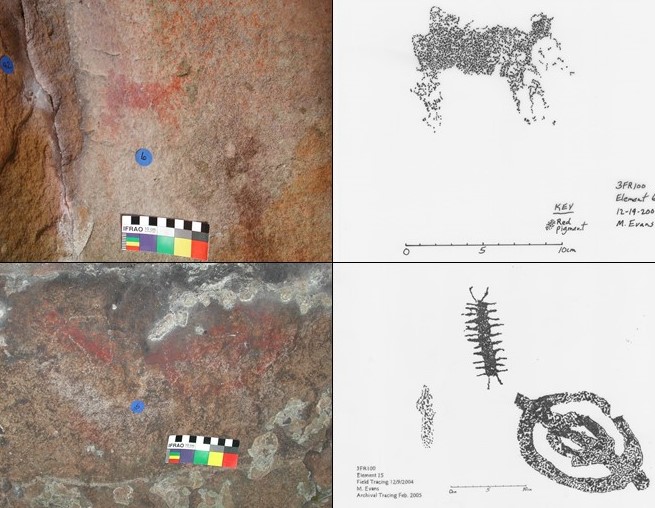
By Jessica Kowalski, UAF Research Station
Feature of the Month - November 2022
Rock art is a unique archeological feature, left intentionally as iconography rather than formed from the residues or byproducts of everyday life. Ancient rock art is associated with geologic formations such as bluff shelters, caves, or vertical rock formations worldwide. November’s feature of the month is rock art recorded in a bluff shelter in Franklin County, Arkansas. This bluff shelter is located just above the Arkansas River and is home to a dense concentration of individual elements, or 38 pictographs on the walls and ceiling of a modestly-sized shelter. This shelter is 19 meters (m) long, 6 m in depth, and 2.5 m in height. All of the elements are painted red with finger strokes, and include both full-bodied and line-drawn examples of anthropomorphic or humanlike images, zoomorphic or animal images, and geometric forms (various shapes and abstract forms) (Figures 1-2). Individual elements are generally between 10–20 cm in both length and width. The number and diversity of elements make the rock art in this shelter one of the most complex examples of rock art in the state.

Rock art is intentional modification of a rock face, created through painting (pictographs) or through pecking (petroglyphs). To date, rock art images have been recorded at over 200 archeological sites in Arkansas, with the highest concentrations in the northwest part of the state. Rock art is usually found in shelters along bluff lines, although examples can occasionally be found on isolated rock formations. Rock art imagery takes many forms, including geometric shapes and realistic or representative depictions of plants, animals, and people. Images can be solitary, combined into panels that may reference a narrative or story, or consist of an assortment of unrelated images. Dating rock art is difficult, but conventional wisdom among the archeological community in Arkansas holds that the majority of these panels date to the Mississippi period (AD 1000-1500) or later (Sabo and Sabo 2005). An excavation at the Narrows rock shelter in 1995 recovered refuse related to creating rock art, including sandstone abrading tools and ground hematite and manganese pebbles used to make pigment (Hilliard 2004). Radiocarbon dates associated with these tools suggest that the rock art at this site was created in the fifteenth century.
Recording rock art has been a goal of the Arkansas Archeological Survey since the 1970s, both in an attempt to understand rock art and preserve important sites. In the early 2000s, archeologists with the University of Arkansas Fayetteville station began a major rock art recording project supported by a grant through the National Endowment for the Humanities. The methods for recording rock art included creating to-scale tracings using mylar (see Figure 4) and using a combination of high-resolution photography and topographic mapping. Visualization software can be used to manipulate lighting and color to highlight rock images not easily seen with the naked eye. Recently, archaeologists with the Arkansas Archeological Survey have been experimenting with photogrammetry, LiDAR, and 3D scanning of shelters to better document and understand these critical resources.
More information about rock art can be found on the Arkansas Archeological Survey’s rock art website or through a popular series publication, Rock Art in Arkansas edited by George Sabo III and Deborah Sabo (2005).

References
George Sabo III and Deborah Sabo (editors)
2005 Rock Art in Arkansas. Popular Series No 5. Arkansas Archeological Survey, Fayetteville.
Hilliard, Jerry E., Gayle Fritz, and Eben S. Cooper
2004 The Archeology of Rock Art at the Narrows Rock Shelter, Crawford County, Arkansas. Arkansas Archeological Survey Research Report No. 31. Arkansas Archeological Survey, Fayetteville.
Feature of the Month Series
Archeological features are elements or structures that are nonportable or cannot be easily removed from a site (such as a wall or a post hole). Archeologists document archeological features extensively in the field to record what will otherwise be destroyed in the process of excavation. The records of these features are often all that is left at the end of an excavation. Excellent record keeping is necessary for these features to provide insight into the archeological record and site formation.
In this series, we present interesting and important archeological features that have helped archeologists to better or more fully understand the sites on which they were working. New features will be added monthly. Find the list of features here.
